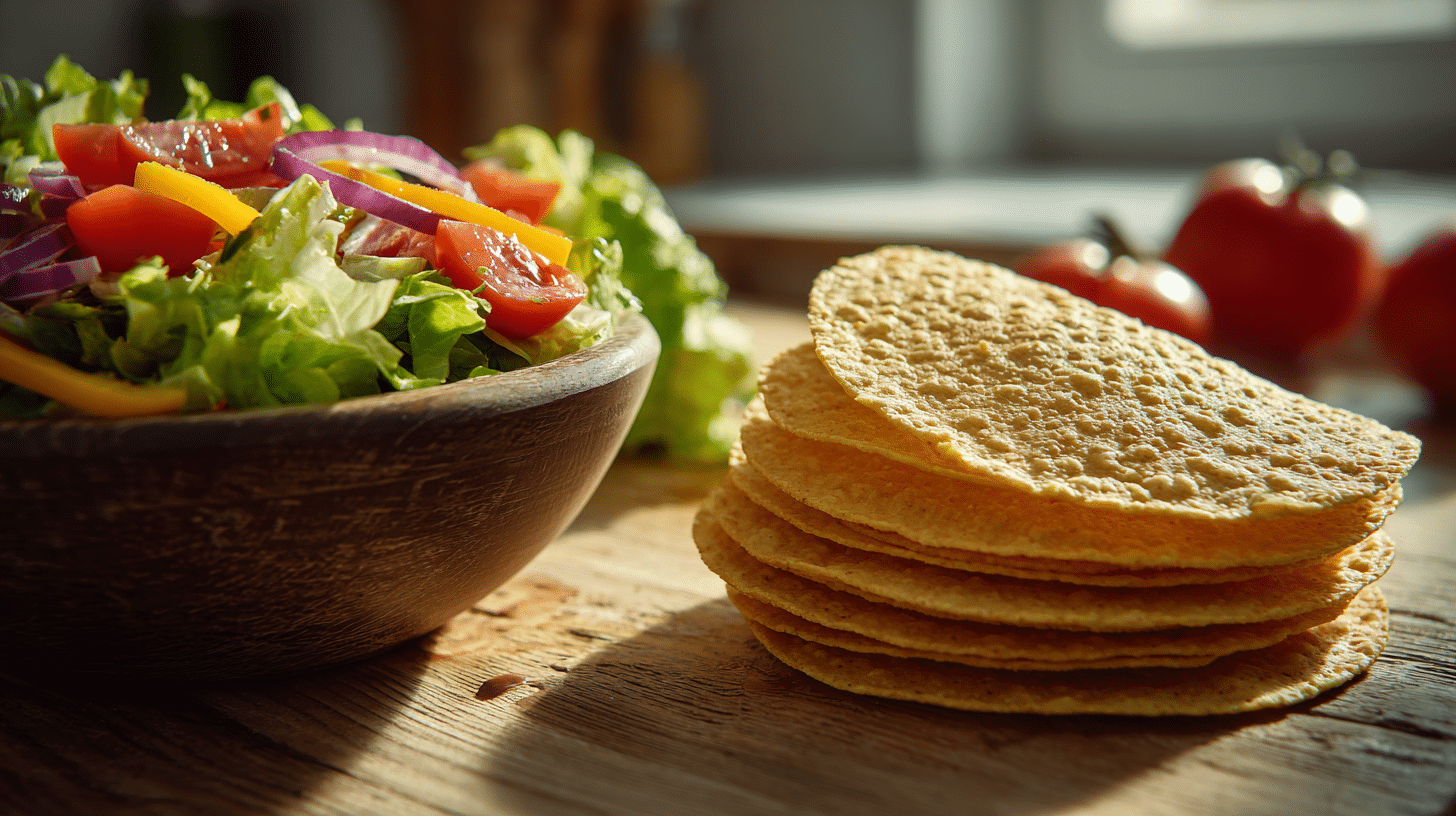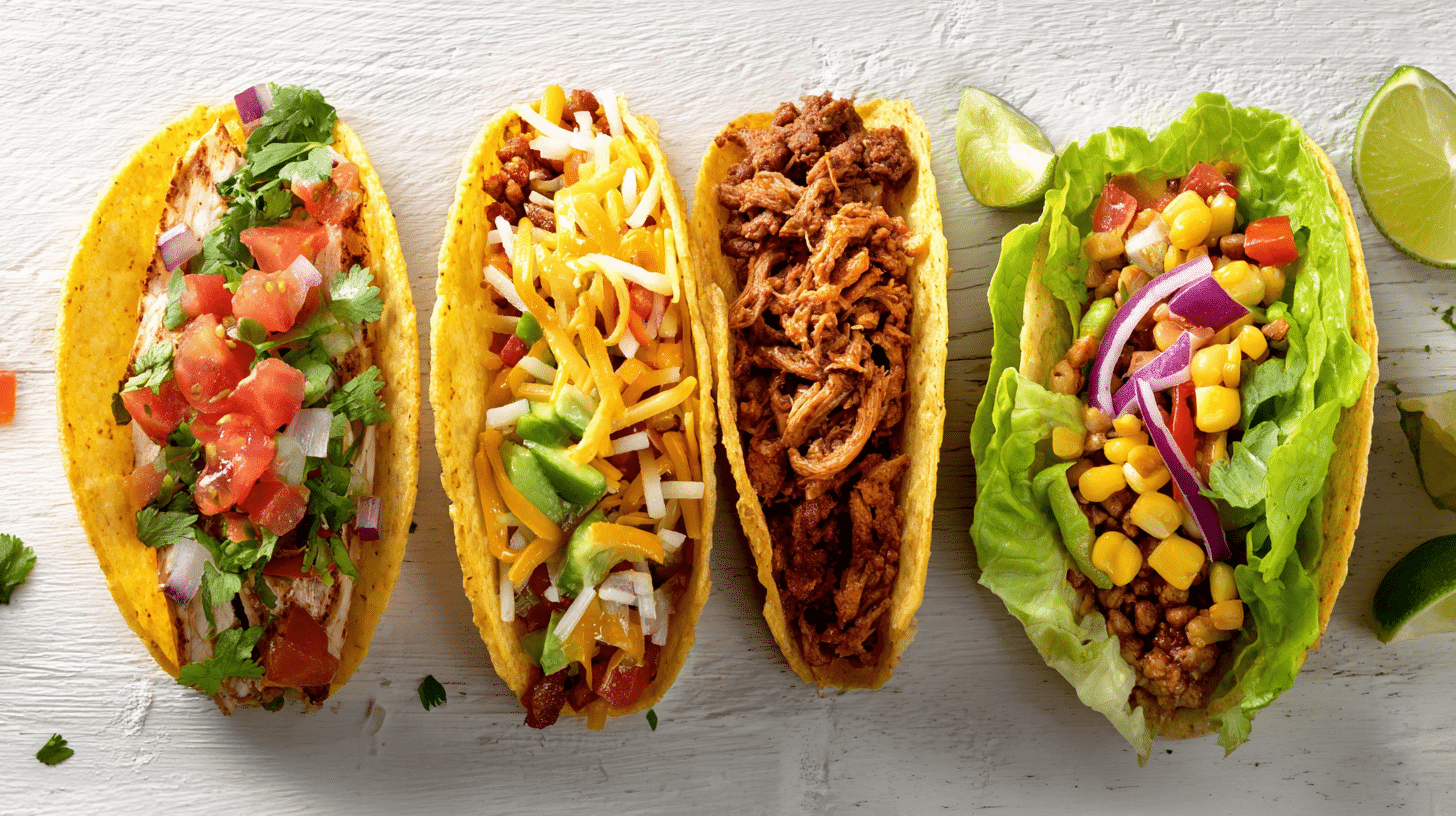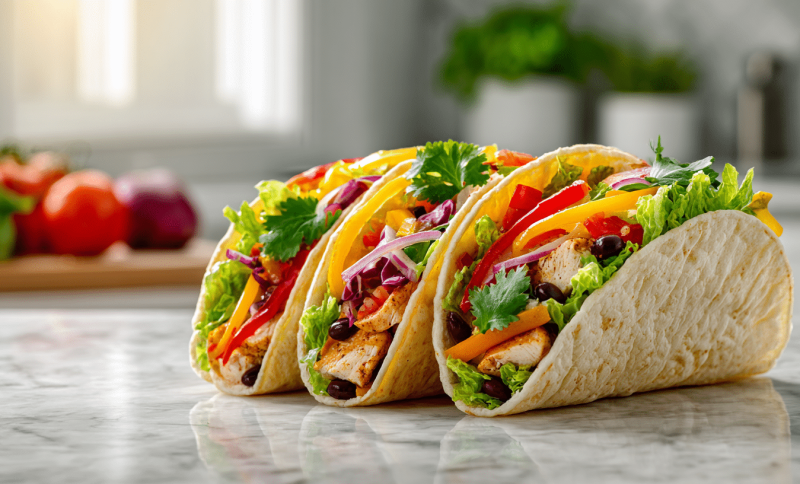Many people think tacos automatically fall into the “junk food” category, but the truth is more complex than most expect.
A basic chicken taco with vegetables can contain fewer calories and more nutrients than a typical sandwich, while a loaded taco with fried shells and heavy toppings can exceed 500 calories.
You’ll learn whether tacos can fit into a healthy diet, how vegetables and shell choices impact nutrition, specific calorie counts across different taco types, which ingredients to limit, and proven strategies for building more nutritious tacos.
Calorie and nutrition information vary by preparation method, portion size, and specific ingredients used. Use these numbers as general guidelines for making informed choices.
Are Tacos Healthy?
The answer depends entirely on what goes inside your taco shell. A taco filled with lean protein, fresh vegetables, and moderate amounts of healthy fats can provide balanced nutrition.
Meanwhile, a taco with fried meat, excessive cheese, and creamy sauces delivers mostly empty calories.
What makes a taco healthy comes down to the balance of protein, fiber, beneficial fats, and micronutrients while avoiding excessive refined carbohydrates, saturated fat, and empty calories.
Health experts generally agree that tacos can be nutritious, but success depends on thoughtful ingredient selection and portion control.
How Vegetables and Shells Help Taco Nutrition

Two simple decisions can dramatically change your taco’s nutritional profile: what you put inside it and what you wrap it with.
These foundational choices determine whether your taco delivers balanced nutrition or mostly empty calories.
1. Veggies as a Nutrition Powerhouse
Vegetables are what separate a balanced taco from a glorified meat sandwich. They add fiber, essential vitamins, antioxidants, and volume without significantly increasing calories.
This combination helps slow digestion and creates lasting satisfaction.
Top vegetable choices for tacos:
- Lettuce and cabbage (crunch and fiber)
- Tomatoes and onions (flavor and nutrients)
- Bell peppers and corn (sweetness and texture)
- Cilantro and jalapeños (fresh taste and metabolism boost)
- Mushrooms and zucchini (umami and bulk)
The strategy that works best is using a high vegetable-to-protein ratio. Layer vegetables under proteins to prevent sogginess and maintain texture throughout the meal.
2. Shell Selection Makes a Major Difference
Your choice of taco shell or tortilla has a significant impact on the overall nutritional profile. This decision alone can add or subtract 100-200 calories per taco.
| Shell Type | Calories (per shell) | Carbs | Fat | Best For |
|---|---|---|---|---|
| Corn tortilla (small) | 50-60 | 12g | 1g | Street tacos, portion control |
| Flour tortilla (medium) | 90-120 | 15-20g | 3-4g | Soft tacos, wraps |
| Hard taco shell (fried) | 50-70 | 7-9g | 3-4g | Traditional crunchy tacos |
| Large flour tortilla | 200-300 | 30-40g | 6-10g | Burritos, oversized tacos |
Corn tortillas typically contain fewer refined ingredients and calories compared to flour versions. Fried hard shells absorb additional oil during cooking, increasing both calories and fat content.
Lower-calorie alternatives:
- Lettuce wraps (5-10 calories)
- Bell pepper halves (15-20 calories)
- Portobello mushroom caps (20-25 calories)
- Zucchini boats (10-15 calories)
Nutrition Breakdown: Different Taco Types

Understanding the calorie and nutrient differences between taco varieties helps you make informed choices based on your daily goals.
1. Basic Beef Taco
The classic American-style taco features seasoned ground beef with standard toppings like lettuce, tomato, and shredded cheese.
Most restaurants and home cooks use 80/20 ground beef, which contains moderate fat content. This combination delivers familiar flavors but can be high in saturated fat depending on preparation methods.
| Calories | Protein | Carbs | Fat | Notes |
|---|---|---|---|---|
| 170-200 | 8-12g | 13-16g | 8-12g | Ground beef, lettuce, cheese |
2. Grilled Chicken Taco
Lean grilled chicken breast provides high-quality protein with minimal saturated fat. These tacos often include fresh vegetables like peppers, onions, and cilantro for added nutrition and flavor.
The preparation method makes a significant difference – grilled or baked chicken contains far fewer calories than fried versions.
| Calories | Protein | Carbs | Fat | Notes |
|---|---|---|---|---|
| 120-150 | 15-20g | 12-15g | 3-6g | Lean protein, vegetables |
3. Fish Taco
Popular varieties include grilled mahi-mahi, tilapia, or cod, often served with cabbage slaw and lime crema.
The fish provides omega-3 fatty acids and lean protein, but creamy sauces can add significant calories.
Battered and fried fish versions contain much higher fat and calorie counts than grilled preparations.
| Calories | Protein | Carbs | Fat | Notes |
|---|---|---|---|---|
| 150-200 | 12-18g | 15-20g | 6-10g | Often includes creamy sauce |
4. Black Bean Taco
A vegetarian option that combines seasoned black beans with vegetables like peppers, onions, and corn.
Black beans provide both protein and fiber, making these tacos particularly filling. The plant-based protein is complete when paired with corn tortillas, creating a nutritionally balanced meal.
| Calories | Protein | Carbs | Fat | Notes |
|---|---|---|---|---|
| 100-130 | 6-8g | 18-22g | 2-4g | High fiber, plant-based |
5. Carnitas Taco
Traditional Mexican slow-cooked pork shoulder that’s tender and flavorful. The cooking process renders much of the fat, but carnitas still contains more fat than leaner proteins.
Authentic preparations use minimal seasoning, letting the pork’s natural flavors shine through with simple toppings like onions and cilantro.
| Calories | Protein | Carbs | Fat | Notes |
|---|---|---|---|---|
| 200-250 | 12-15g | 13-16g | 12-16g | Higher fat from pork |
6. Street Taco
Small, simple tacos served on corn tortillas with minimal toppings – typically just meat, onions, cilantro, and salsa.
The focus is on high-quality protein and traditional flavors rather than heavy additions. These portion-controlled tacos originated from Mexican street vendors and emphasize authenticity over size.
| Calories | Protein | Carbs | Fat | Notes |
|---|---|---|---|---|
| 80-120 | 8-12g | 8-12g | 3-6g | Minimal toppings |
These numbers represent single tacos with standard portions. Adding extras like cheese, sour cream, or guacamole increases calories by 50-100 per tablespoon.
Ingredients to Avoid or Limit

Certain ingredients can quickly transform a balanced taco into a high-calorie, low-nutrition meal. Being aware of these helps you make better choices without eliminating foods you enjoy.
|
Fried shells and components:
Heavy dairy additions:
Processed and high-sodium items:
Sugary and high-calorie sauces:
|
The strategy isn’t complete avoidance but rather portion awareness. A small amount of cheese or a tablespoon of sour cream won’t derail nutrition goals, but heavy-handed application will.
How to Build Healthier, More Balanced Tacos
Small changes in ingredient selection and preparation methods can transform tacos from indulgent treats into nutritious, satisfying meals.
1. Smart Protein Choices
Start with lean proteins that provide essential amino acids without excessive saturated fat. Grilled chicken breast, white fish, shrimp, and lean cuts of beef work well.
Plant-based options like black beans, pinto beans, lentils, and seasoned tofu offer protein plus fiber.
Cooking method matters significantly. Grilling, baking, or sautéing with minimal oil produces better results than deep-frying or cooking in heavy oils.
2. Maximize Vegetable Content
Aim to fill at least half your taco with vegetables. This increases nutrient density, adds fiber for satiety, and provides volume without many calories.
Mix textures and colors for both visual appeal and varied nutrition.
3. Choose Beneficial Fats Wisely
Instead of heavy cheese and sour cream, focus on fats that provide nutritional value. A few slices of avocado deliver healthy monounsaturated fats, fiber, and potassium.
A sprinkle of seeds or nuts adds crunch plus beneficial oils.
4. Lighten Your Sauces
Replace heavy, creamy sauces with fresh alternatives that add flavor without excessive calories. Fresh salsa contains only 10-15 calories per tablespoon, while pico de gallo has even fewer at 5-10 calories.
Greek yogurt mixed with lime and spices provides 15-20 calories per tablespoon but adds protein. Hot sauce delivers bold flavor for just 0-5 calories per tablespoon, and fresh lime juice adds brightness for only 2-3 calories per squeeze.
5. Practice Portion Control
Consider having two smaller, well-built tacos instead of one oversized version.
This approach often provides better satisfaction and allows you to enjoy variety without overconsumption.
What People Actually Say About Healthy Tacos
Beyond the nutrition numbers, people who’ve switched to healthier taco builds report noticeable improvements in how they feel after eating.
These aren’t just theoretical benefits; they’re real experiences from actual taco lovers.
1. Cost-Effective and More Flavorful
“I use plain greek yogurt in place of sour cream for my tacos. It’s almost impossible to tell the difference with all the other stuff in the tacos and it saves a lot of calories.”: Reddit user, /r/EatCheapAndHealthy
Tacos can be surprisingly healthy when you load them with vegetables, choose lean proteins, and use simple swaps like Greek yogurt instead of sour cream.
They’re easy to customize for different dietary needs while still tasting great, making healthy eating enjoyable for everyone.
2. Better Digestion and Gut Health
“Black beans and roasted sweet potatoes with diced onions, chopped cilantro and Mexican crema in corn tortillas. I always have the best poop the next day.”: Reddit user, /r/mexicanfood
The fiber from beans and fresh vegetables creates noticeable digestive improvements. As one user bluntly noted about their bean and sweet potato tacos, the high-fiber content leads to better bowel movements the following day – a clear sign of improved digestive health.
3. Significant Calorie Reduction Without Sacrifice
“I’ve been advised by my doctor to improve my diet, focusing on incorporating more vegetables and reducing calorie intake … I’m confident this change has helped me cut back by several hundred calories.”:Reddit user, /r/tacos
The combination of protein, fiber, and healthy fats keeps people full longer without the heavy, sluggish feeling that often follows high-fat, processed meals.
This prevents the energy crashes and snack cravings that can derail healthy eating goals.
The Bottom Line
Tacos can absolutely be healthy when built with lean proteins, plenty of vegetables, and mindful portions.
The shell choice, cooking methods, and topping selections determine whether your taco supports or undermines your nutrition goals.
Focus on maximizing nutrients per calorie rather than restricting entire food categories.
Start with a base of lean protein and vegetables, choose corn tortillas or whole-grain options when possible, and experiment with fresh sauces instead of heavy creams.
Small adjustments often produce significant improvements in both taste and nutrition.
What’s your favorite strategy for building healthier tacos? Share your go-to combination in the comments below.













